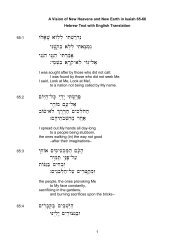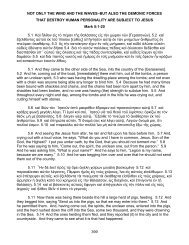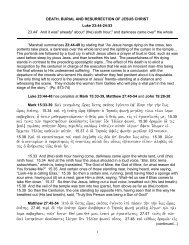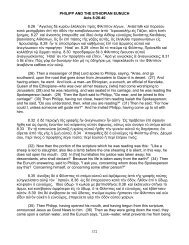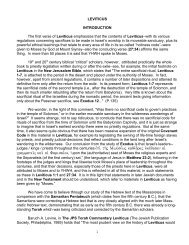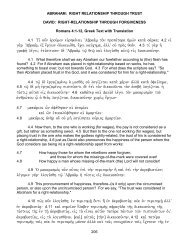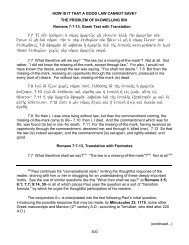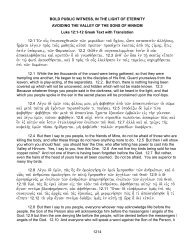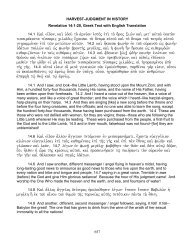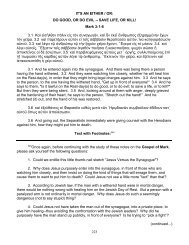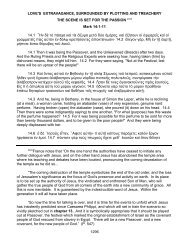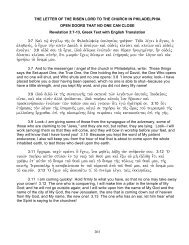Revelation 8-9 - In Depth Bible Commentaries
Revelation 8-9 - In Depth Bible Commentaries
Revelation 8-9 - In Depth Bible Commentaries
Create successful ePaper yourself
Turn your PDF publications into a flip-book with our unique Google optimized e-Paper software.
930 9319.3 And out of the smoke came out grasshoppers into the earth, and authority was930A classic case of the eye of the copyist skipping from the first appearance of a wordto its second appearance, and leaving out the material in between, occurs here. The phraseê ôï êáðíï ôï öñÝáôïò. êá, ek tou kapnou tou phreatos, kai, “out of the smoke of thepit, and” is omitted by the first writer of Sinaiticus, the Old Latin manuscript h (see) and a fewmanuscripts of the Latin Vulgate (see). Here, the eye of the copyist has skipped from the firstappearance of ek tou kapnou to its second occurrence, leaving out the material between thetwo phrases. Before we criticize the copyist for this, we need to attempt to copy a book like<strong>Revelation</strong> by hand! It is far more difficult to do successfully than we might think! The omissiondoes not change the meaning of <strong>Revelation</strong>.931We have remarked earlier how the Exodus story of the Ten Plagues is closely relatedto the sounding of the seven trumpets of <strong>Revelation</strong> 8-9. Here, we are again reminded ofthose Ten Plagues--this time the eighth plague, as described in Exodus 10:12-20. But thereis another biblical story of an invasion of grasshoppers, found in Joel 1:2-2:11, which likewisecan be seen as illustrative of what John is depicting, and which is describing the torments thatcome in history when the day of YHWH comes.Hendricksen comments that “These locusts, unbelievably terrible in their destructivepower, are a fit symbol of the far more terrible and destructive hellish locusts which [John] isabout to picture. Under the symbolism of a locust plague John describes the powers andinfluences of hell operating in the hearts and lives of wicked [people].” (P. 121) See theVisions of Hermas, 4.1.6, where Hermas sees fiery locusts that came out the mouth of agreat beast.Hough comments, “Out of this great cloud emerge monstrous locusts. They are freefrom their prison, but they are under the complete and constant mastery of God.” (P. 576)“To nearly all historicist commentators, the locusts (verse 3) represent the Saracens(Muslim Arabs) and their campaigns against the Eastern Roman [Byzantine] Empire fromabout 612 to 763. The king (verse 11) that is over them is Mohammed...These locusts, quiteunlike the natural locust, were commanded by their king not to harm the grass of the earth, orany green thing (verse 4). A striking parallel appears in Mohammed’s instruction in theKoran: ‘Destroy no palm trees, nor any fields of corn, cut down no fruit trees...“Mohammed adopted the policy of making converts by the sword in 612, from whichtime the Muslim Arabs began to attack the eastern churches and seek to forcibly convertEurope from Christianity to Islam. Their ravages were checked by their defeat at Tours byCharles Martel, in 732. <strong>In</strong> the year 763, the Muslims ceased from their policy of aggressionand moved their capital to Baghdad on the Tigris. Thus ‘from the time that Mohammed beganto propagate his imposture, A.D. 612, to the building of Baghdad, when they ceased from theirravages, A.D. 763, are just 150 years.’“Matthew Henry takes an entirely different approach...He sees the star fallen fromheaven (verse 1) as Boniface, the third bishop of Rome, who assumed the title of universalbishop. Having forfeited the ‘keys of the kingdom of heaven,’ he now has the keys of hell, to(continued...)435



